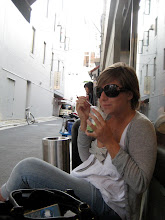 The article writes:
The article writes:Noosa university graduate Monica Romanyk is not setting out for a new career in Germany to reinvent the wheel, just the way it is used to get around.
And for this 24-year-old regional and urban planner, who has just gained her degree from the University of the Sunshine Coast, her lateral thinking will focus on non-motorized eco-mobility.
Monica has gained a six month internship with ICLEI a local government organization committed to sustainability, and flew out yesterday for Bonn.
The international student from Canada, who decided to study at USC after holidaying in Noosa five years ago, said she would be using the Sunshine Coast as a comparison of her overseas research and would be keen to come back and sort out some sustainable cycling options locally.
That is if she is not head hunted in Germany.
"The Sunshine Coast was a really interesting place to study regional planning because of its growth." she said. "I'm excited about working in the field... it has so much potential."
"We have to work with communities and not forget the social implications of planning." Monica persued her interest in social planning through a minor in sociology. "As an intern with ICLEI, I will help plan the first EcoMobility World Congress in Korea in October 2011. This will involve researching successful local government active transport initiatives worldwide, such as bicycle lending."
Monica's studies were enhanced by a recent visit to Wroclaw, Poland as a part of a program with UN Habitat, the United Nations agency for human settlements. "I applied to the European Urban Summer School and was selected to join 50 young professionals and academics from a range of countries to discuss sustainable urban planning with UN Habitat."
"We discussed all aspects of sustainability- social, economic, environmental- in relation to the past and present ways of planning."
The last few months have been some of the busiest for me. I recently wrote my final university exams and have completed my studies at the University of the Sunshine Coast. I can now call myself a regional and urban planner!
It was my intention to make my way to Europe to find work in my field and to gain more of an international perspective. Well it has all happened very quickly! I am writing from Bonn, Germany where I arrived this morning to start a new chapter. As you can see in the article above I will be here to work with ICLEI for six months as an intern in EcoMobility.
I look foward to starting my professional career! Although it was hard to say goodbye to Australia. I will miss it.. I will miss the climate. It was a great experience, I enjoyed my studies and the Sunshine Coast was an ideal place to live while I was a student.
M.


 Graz Art Museum, Austria
Graz Art Museum, Austria




 Further we were presented with our schedule for the next 10 days which was proven to be jam packed and intense, none the less rewarding and enjoyable! Working in groups, mine including sociologists, engineers, architects and planners from Portugal, Italy, Turkey, Israel, and Poland we were given 3 cases to analyse, research, discuss and come up with solutions for the transformation or rehabilitation of space and successful outcomes. Before each case was started a site tour was organized to visit and experience the challenges we would work to overcome.
Further we were presented with our schedule for the next 10 days which was proven to be jam packed and intense, none the less rewarding and enjoyable! Working in groups, mine including sociologists, engineers, architects and planners from Portugal, Italy, Turkey, Israel, and Poland we were given 3 cases to analyse, research, discuss and come up with solutions for the transformation or rehabilitation of space and successful outcomes. Before each case was started a site tour was organized to visit and experience the challenges we would work to overcome.











 (photos: newyorktimes.com)
(photos: newyorktimes.com)